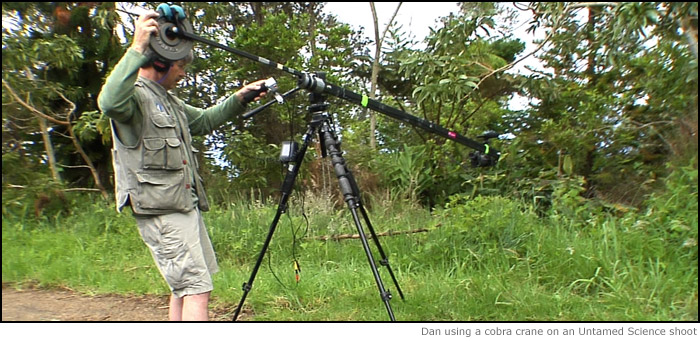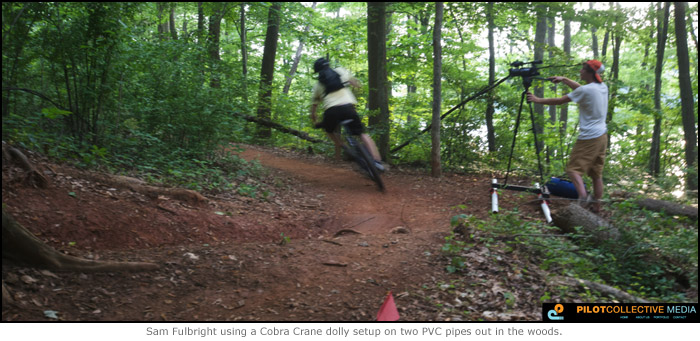Moving Shots: Cranes, Dollies and Steadicams
Though most viewers don’t notice, one of the techniques that sets high-budget films apart from the rest is that many of the shots are moving. The movement isn’t just panning on a tripod; it is a steady physical movement of the camera up, down, or through the action being recorded. Even lower budget films can simulate the look of high-priced features by including these dynamic shots.
In filmmaking, camera movements are often referred to as dollies or dollying the camera. Dolly shots can be set up on rails or cables. Sometimes similar movement is accomplished through the use of cranes or jibs. Filmmakers can also use simple steady cams to stabilize handheld camera movement.
Here we’ll show you some very basic setups that can make a low-budget film look like a multi-million dollar feature.
Cranes
A crane extends a camera on the end of a long pole with a counterweight on the opposite side. This setup allow smooth movement of the camera up, down, left, and right. This is an image of us using one in Hawaii.
Very small cranes can be attached to a tripod head and moved freely in all directions. The simplest crane we’ve found is the CobraCrane setup. For around 350 USD you can get a stellar rig that you mount to your tripod for some amazing shots! They use standard weight-set weights and can be broken down to fit inside your luggage or car. Like most camera-movement gear, you’ll need some practice to get dynamic shots.
One thing that will help you capture quality crane shots is being able to clearly see what the camera is shooting. You can either watch the LCD screen on your camera or rig up a small LCD monitor on your tripod that’s wired to your camera. A separate LCD monitor allows you to stay focused on your camera movement relative to the action that you’re trying to capture. You may also want to consider some of the tripod-mounted wired camera control devices that allow you to focus, record, and zoom remotely for greater control. VariZoom offers various options. The cheaper solution is to mount your camera remote control with Velcro to your tripod so you are able to start and stop recording without dashing up to the camera on the other end of the crane.
What makes crane shots grab your attention is the camera moving past objects that are both near and far from the camera. It greatly increases the feeling of motion and perspective.
Dollies
A dolly shot is where the camera is mounted to wheels on a platform and tracks movement left to right or forward to backward. Here a few ways to make a beautiful and steady dolly move for your videos.
Standard dollies
The simplest dolly shot can be created on flat, level floors with someone pushing the camera person in a wheeled chair. Skateboards work for the same purpose. However, if you want to increase the steadiness, you’re going to need some sort of dolly setup. Again, we like CobraCrane’s stock.
Cable dollies
Cable dollies consist of a single rope or wire connected by two points. The camera is then mounted to a device that can move along the dolly. (Just don’t make the angle of the cable too steep or your camera will fly at dangerous speeds and end up destroyed at the far end! Make sure to test your setup with one person at each end of the cable.) Check out our full tutorial on making a cable dolly.
Camera-stabilization systems
“Steadicam” is a brand name that has come to refer to any number of camera-stabilization systems (like calling all facial tissues “Kleenex”). There are several ways to stabilize handheld camera movements. Most of them require adding a small bit of weight to the camera, usually off of an extension below the camera.
We found a great example video that shows how much smoother a camera shot is with a small home-built image stabilizer. Check out their tutorial at http://poormanscamerastabilizer.org



































































































